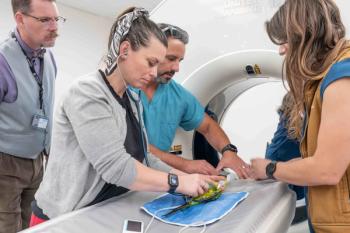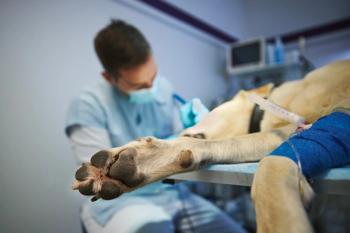
On the Forefront: Frameless stereotactic CT-guided needle brain biopsy
Recently, a technique has been developed that allows veterinary neurosurgeons to obtain a biopsy sample of the brain: a frameless stereotactic CT-guided needle biopsy.
In animals suspected of having neurologic diseases, the diagnostic workup includes evaluating the animal's signalment and history and conducting thorough physical and neurologic examinations. Depending on the findings of these evaluations, a preliminary minimum database (i.e. a complete blood count, a serum chemistry profile with electrolytes, urinalysis, thoracic radiography, and abdominal ultrasonography) may also be needed. In animals suspected of having brain diseases, the diagnostic workup includes all of the evaluations mentioned above as well as specific tests such as computed tomography (CT) or magnetic resonance imaging (MRI) and cerebrospinal fluid analysis. With the development and adaptation of CT and, more recently, MRI for animals, it is now possible to identify and localize brain lesions. However, these imaging techniques are limited because they can only tell us whether there is a lesion in the brain. They cannot identify the cause of the lesion or whether it is treatable. Often, it is not possible to differentiate a brain tumor from an inflammatory or infectious disease.
Figure 1. The frameless stereotactic CT-guided needle brain biopsy apparatus. The apparatus is placed above the dogâs trunk, and a flexible arm holding the biopsy needle guide is mounted and fixed in position over the dogâs head to target the lesion. The biopsy needle guide is made of plastic to avoid image artifacts.
As with many diseases, a biopsy is the only definitive way to diagnose a brain disease and determine whether treatment, excision, or both are possible. A biopsy may help to differentiate a tumor type or the type of infection or inflammation (i.e. fungal, bacterial, protozoal, viral, parasitic, immune-mediated). Until recently, performing a biopsy has required brain surgery with its complement of postoperative complications. Opening the skull is always risky, and with brain surgery, only superficial lesions may be accessible.
Figure 2. The Sedan Side-Cutting Biopsy Needle.
A new biopsy option
A stereotactic system uses three-dimensional coordinates to locate a site in the brain to be accessed surgically. Conventional stereotactic systems require the use of a stereotactic frame attached to a patient. Recently, a technique has been developed that allows veterinary neurosurgeons to obtain a biopsy sample of the brain: a frameless stereotactic CT-guided needle biopsy. This new technique does not require the complicated and expensive stereotactic frames used in previous studies.1-3 In this new procedure, the stereotactic frame is replaced by a biopsy needle guide inserted into a surgical arm, which, in turn, is attached to the apparatus (Figure 1). This technique is superior to surgical biopsies because it allows a surgeon to access places a scalpel cannot and do so without damaging surrounding tissues. The procedure is done in real time so that the clinician knows exactly where and how far to advance the needle. Adequate sample sizes (1.2 x 4 mm) are obtained for cytologic and histologic differentiation between infection, inflammation, and tumor.
How it works
An animal is anesthetized in the CT suite, the hair on its head is clipped over the region of interest, and the skin is marked with indelible ink to correspond with the transverse plane. Several barium marks are applied along the ink line, and transverse contrast CT images are obtained. These images display the lesion in the brain as well as the barium lines over the skin. The barium line best aligned with the intracranial lesion is chosen as a reference point for the skin incision and the craniotomy. The target is localized on one transverse image, and the table position is noted.
Figure 3. Dr. Filippo Adamo, after performing a burr hole craniotomy with a hand drill, inserts the brain biopsy needle into the biopsy needle guide. The apparatus and the needle are prepositioned to target the lesion. The needle is advanced under CT guidance.
After a sterile scrub is done on the target area, a small skin incision is made. The underlying muscles are also incised and dissected from the calvaria, and a hand drill is used to make a small hole in the calvaria. The apparatus holding the biopsy needle is then mounted over the patient's head, and the needle is aligned to the lesion by using serial transverse CT scans. A Sedan Side-Cutting Biopsy Needle (Elekta) is used, which is a 2.1-mm-diameter side-holed brain cannula that includes an outer and inner needle (Figure 2). The outer needle has a blunt, nonbeveled end, while the windows have cutting edges. The distance from the tip of the needle to the center of the lesion is measured by using CT, and the surgeon then advances the needle (Figures 3-5). Two or three samples are usually collected through the lateral window of the biopsy needle. A gentle negative pressure is created with a 10-ml syringe applied to the proximal end of the inner needle to introduce the sample to be collected into the needle window, and the inner biopsy needle is rotated 180 degrees to cut the collected sample. The inner needle is then removed (the external needle is left in place), and the sample is extracted by flushing the needle with air.
Figure 4. A contrast-enhanced transverse CT image of an 11-year-old dachshund with acute signs of right forebrain disease. A contrast-enhancing lesion is evident in the white matter in the right temporoparietal lobe (arrow). Ventricular asymmetry is also evident (arrowheads).
After collecting the first proximal sample, the inner needle is replaced into the external needle, and both needles are advanced to a precise location, according to the CT measurements, to obtain one or two additional samples. (We collect at least one sample from the center of the lesion and one from the periphery.) The samples are submitted for cytologic and histologic examination and bacterial and fungal culture and antimicrobial sensitivity testing. To ensure that the samples are diagnostic, the cytologic examination is performed before the apparatus is removed.
Typically, this procedure takes about two hours. Potential risks are the same as those reported with the stereotactic technique and include seizures, intracranial bleeding, coma, and death. Usually patients are kept in intensive care for 24 hours, allowing clinicians to administer supportive care, monitor vital signs, and detect any signs of neurologic deterioration. Patients are usually discharged 48 hours after the biopsy.
Figure 5. The same dog as in Figure 4. Under the guidance of contrast-enhanced transverse CT scans, the biopsy needle is advanced into the exact location of the lesion. In this case, the histologic diagnosis was granulomatous meningoencephalitis. At the time of the definitive diagnosis, the dog was already receiving corticosteroids, and its neurologic signs were severe. Combination prednisone and cyclosporine therapy was initiated and partially reversed the neurologic signs, and during the following three weeks the dog improved from nonambulatory tetraparetic to ambulatory hemiparetic. At an 8-month recheck, the dog exhibited only ataxia, and the owner is happy with the outcome
Why use this technique?
A definitive diagnosis allows clinicians to give owners a more exact prognosis, which can also help clinicians determine whether treatment is likely to succeed.The procedure is being done at the University of Wisconsin, School of Veterinary Medicine. It has been used in dogs to diagnose granulomatous meningoencephalomyelitis and various brain tumors; however, it could also be applied in cats. The procedure costs $1,200, and preoperative testing is required, including an MRI scan that costs $1,800, to determine whether a lesion is present. If you would like more information about this procedure, write to Dr. Filippo Adamo at the Department of Medical Sciences, School of Veterinary Medicine, University of Wisconsin, 2015 Linden Drive West, Madison, WI 53706; call (608) 263-7600; fax (608) 265-8276; or e-mail
REFERENCES
1. Koblik, P.D. et al.: CT-guided brain biopsy using a modified Pelorus Mark III stereotactic system: Experience with 50 dogs. Vet. Radiol. Ultrasound 40 (5):434-440; 1999.
2. Moissonnier, P. et al.: Stereotactic CT-guided brain biopsy in the dog. J. Small Anim. Pract. 43 (3):115-123; 2002.
3. Moissonnier, P. et al.: Accuracy testing of a new stereotactic CT-guided brain biopsy device in the dog. Res. Vet. Sci. 68 (3):243-247; 2000.
The information for "On the Forefront" was provided by Filippo Adamo, DVM, DECVN, Department of Medical Sciences, School of Veterinary Medicine, University of Wisconsin, Madison, WI 53706.
Newsletter
From exam room tips to practice management insights, get trusted veterinary news delivered straight to your inbox—subscribe to dvm360.






